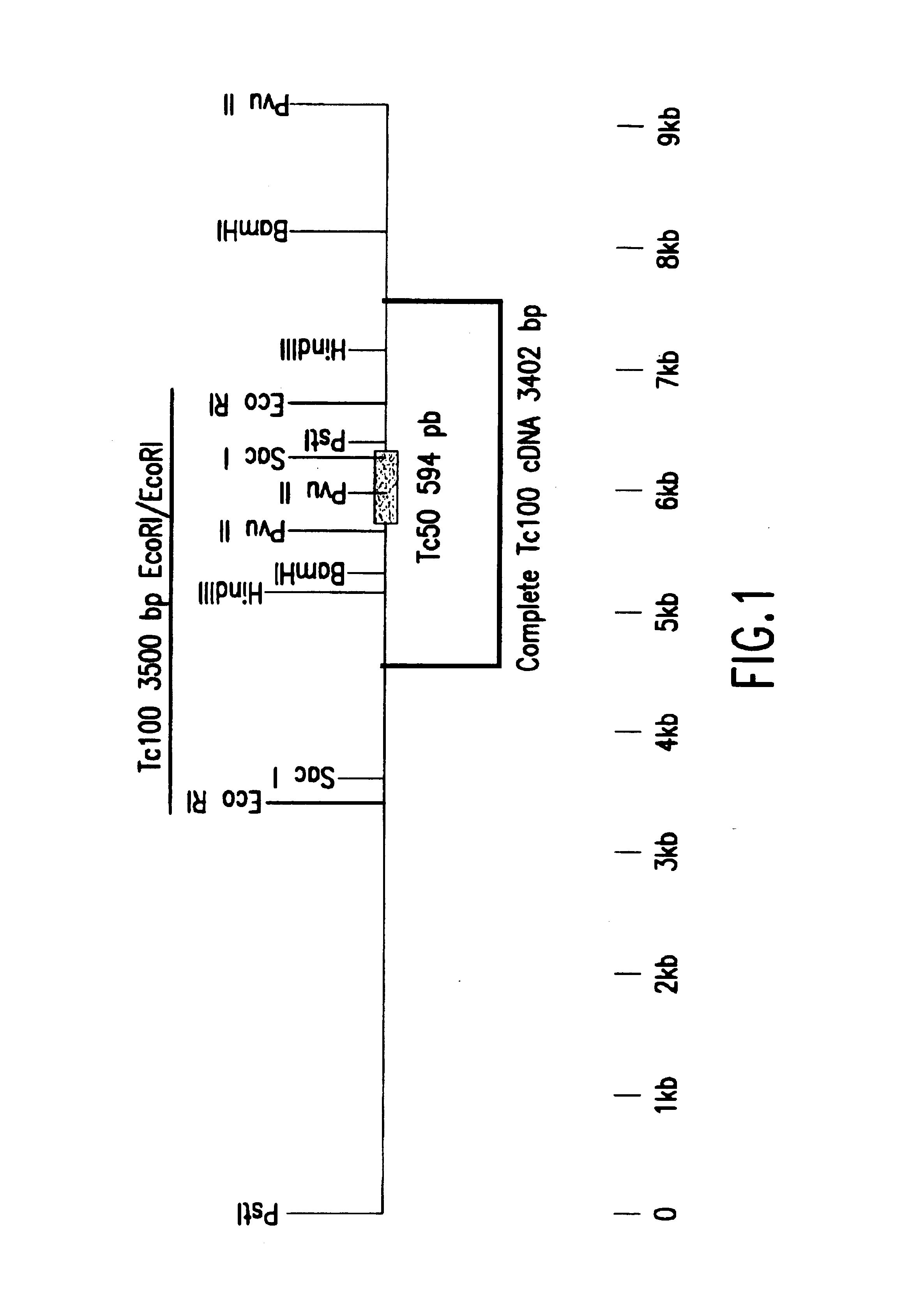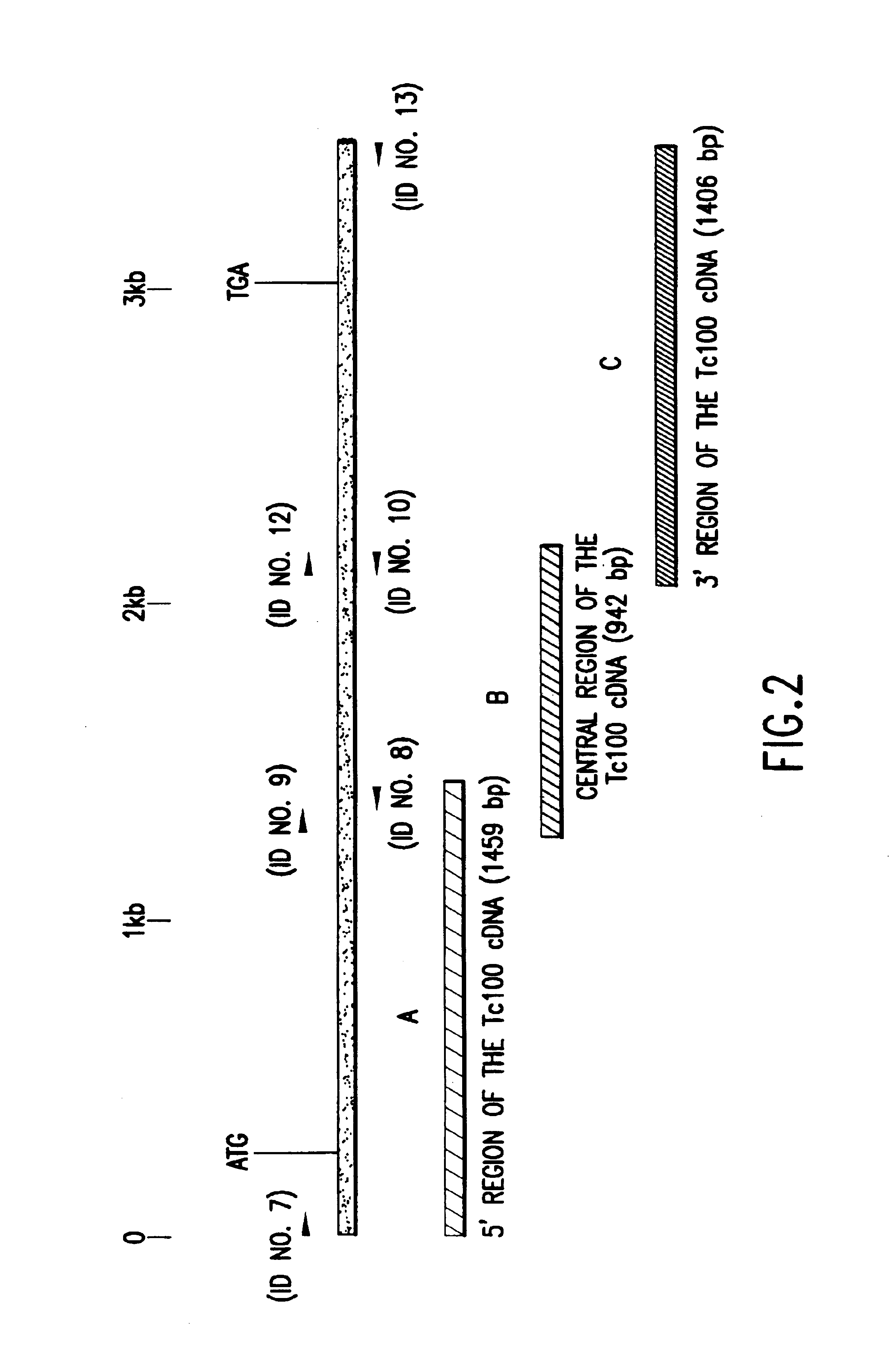Trypanosoma cruzi antigen, gene encoding therefor and methods of detecting and treating chagas disease
a technology of chagas disease and antigen, which is applied in the field of trypanosoma cruzi antigen, gene encoding therefor and methods of detecting and treating chagas disease, can solve the problems of insufficient quantity and quality of antigens, additional difficulty in reproducibility of different preparations, and disease becoming a worldwide problem
- Summary
- Abstract
- Description
- Claims
- Application Information
AI Technical Summary
Benefits of technology
Problems solved by technology
Method used
Image
Examples
example 1
Isolation of the Tc50 Clone
[0078]An expression library was constructed from Trypanosoma cruzi genomic DNA fragments. The T. cruzi, strain G (YOSHIDA. N, (1933) (17)), DNA isolated from the metacyclic trypomastigote stage was digested with the enzyme DNase I. After selection of the fragments according to their size, they were ligated to synthetic EcoRI adaptors and cloned into the EcoRI site of lambda gt11 vector DNA (Young and Davis, 1983 (3); Cotrim et al., 1990) (4).
[0079]The clone, called Tc50 by the applicant, was isolated from the library by immunological screening with the aid of a mixture of sera from patients suffering from the chronic phase of the Chagas disease.
[0080]The Tc50 phage clone was purified, amplified and the insert was detected by the PCR (“Polymerase Chain Reaction”) technique with the aid of the primers:
[0081]SEQ ID NO: 3 5′ (GGTGGCGACGACTCCTGGAGCCCG)3′ 24, and
[0082]SEQ ID NO: 4 5′ (TTGACACCAGACCAACTGGTAATG)3′ 24, corresponding respectively to the nucleotide s...
example 2
Expression of the Tc50 Clone in Escherichia Coli
[0085]The construct pGEX-Tc50 (198 aa) synthesizes, in the bacterium DE5alpha, a protein fused with GST (“Glutathione S Transferase”), with an apparent molecular mass of 50 kDa, which is detected by SDS-PAGE polyacrylamide gel electrophoresis (SDS: sodium dodecyl sulfate) (Laemmli, 1970 (6)). The reactivity of the protein towards chagasic human sera was confirmed by the Western blotting technique (Towbin et al., 1979 (7)) with the aid of the same mixture of chronic phase chagasic sera which is used for screening the lambda gt11 library.
[0086]The soluble fraction of the recombinant GST-Tc50 protein obtained after lysis of the bacterial extracts by ultrasound was purified by affinity chromatography on a glutathione agarose column (Sigma), according to the method of Smith and Johnson, (1988) (8).
[0087]The antigenic properties of the recombinant GST-Tc50 antigen were tested by ELISA (Voller et al., 1975 (9)). Microtiter plates (Maxisorp (...
example 3
Identification of the Native T. Cruzi Protein having the Antigenic Determinants of the Tc50 Clone
[0089]The detection of the native T. cruzi protein was performed after immunopurification of a mixture of chagasic human sera on the corresponding recombinant protein called PTc50 by the applicant.
[0090]The eluate of monospecific polyclonal anti-bodies which is obtained was used as probe, in Western blotting, on total protein extracts of different stages of the parasite. The selected antibodies specifically reacted with a protein of apparent molecular mass 100 kDa, called PTc100 by the applicant, which is expressed in all the tested strains of the parasite.
PUM
| Property | Measurement | Unit |
|---|---|---|
| Luminescence | aaaaa | aaaaa |
Abstract
Description
Claims
Application Information
 Login to View More
Login to View More - R&D
- Intellectual Property
- Life Sciences
- Materials
- Tech Scout
- Unparalleled Data Quality
- Higher Quality Content
- 60% Fewer Hallucinations
Browse by: Latest US Patents, China's latest patents, Technical Efficacy Thesaurus, Application Domain, Technology Topic, Popular Technical Reports.
© 2025 PatSnap. All rights reserved.Legal|Privacy policy|Modern Slavery Act Transparency Statement|Sitemap|About US| Contact US: help@patsnap.com


